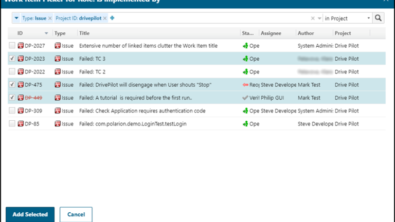Model Based Design (MBD) with Polarion ALM

MBD or model based design is a popular approach in system engineering and software development circles. As engineers work with product requirements, they use model based design tools to better understand those requirements, often refining or even developing new requirements. In some cases, MBD is used for low level design, such as developing complex algorithms, understanding modal/ logical behaviors or designing the software architecture. As companies embark on a digital twin strategy, MBD plays an important role as often these models can be executed or simulated. Depending on the type of model, through simulation, engineers can validate early product requirements or even find potential pitfalls or bugs early on in the product development lifecycle when those issues costs less to resolve and fix. Even better, when products are actually connected to a network, through the use of the internet of things (IoT), engineers can use the products telematics and operational product data and feed this information back into engineering. Now these digital twin models can be used to either troubleshoot the product, drive improvements or provide the foundation to create new iterations of the product.
This all sounds very exciting, but what options are available to customers that are leveraging MBD and using Polarion? How does Polarion ALM work with MBD tools? Let’s explore the options in more detail.
Whether you using MBD for system engineering, software engineering or algorithm development, there are a wide range of Polarion integrations available to support MBD. Currently, Matlab Simulink, Sparx Enterprise Architect, IBM Rhapsody and Siemens own Teamcenter modeling are all available.
The integrations allow engineering teams working with models to ensure that their work is tightly coupled to the software engineering lifecycle being managed by Polarion. Modeler’s can create traceability links between the model artifacts and the product requirements, thus ensuring the requirements have appropriate coverage. Now when product requirements are either updated, deleted or changed inside of Polarion, engineers can quickly determine what impact this will have on the low level design – now represented by digital models. The opposite is also true, when the model might not be able to meet the design requirements, we can quickly determine what impact this will have on the total product requirements.
For some integrations, engineers can view the visual model representations inside of Polarion. In other cases, a hyperlink is provided allowing you to quickly navigate back to the modeling tool to view the model.
Modeling teams can also take advantage of Polarion ALMs comprehensive task and planning management ensuring that their modeling activities are kept to plan and within budget. Other Polarion features can also be leveraged by modeling teams such as Polarion extensive test management capabilities.
 EA Artifacts viewed inside of Polarion ALM
EA Artifacts viewed inside of Polarion ALM
Be sure to browse our Extensions Portal for yourself with hundreds of extensions for Polarion ALM that work with your existing toolchains. To learn more about Polarion ALM and how it can help to modernize your MBD toolchain through Collaboration, Traceability and Reuse contact your Polarion sales advisor or better yet Test Drive Polarion ALM Today!
Below are direct links to the MBD integrations currently available on the Polarion extension site:


